

Sweet Search. British Museum: Ancient Egypt. Carnegie Museum of Natural History: Life in Ancient Egypt. Life in Ancient Egypt Welcome to Life in Ancient Egypt, a companion online exhibition to Walton Hall of Ancient Egypt at Carnegie Museum of Natural History.
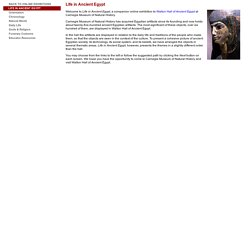
Carnegie Museum of Natural History has acquired Egyptian artifacts since its founding and now holds about twenty-five-hundred ancient Egyptian artifacts. Discovering Ancient Egypt. NOVA: Explore the Pyramids. Explore Ancient Egypt. Explore Ancient Egypt With 360-degree and other imagery, walk around the Sphinx, enter the Great Pyramid, visit tombs and temples, and more.
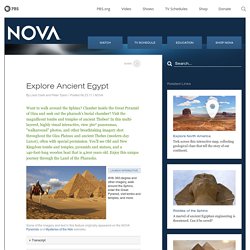
Want to walk around the Sphinx? Clamber inside the Great Pyramid of Giza and seek out the pharaoh's burial chamber? Visit the magnificent tombs and temples of ancient Thebes? In this multi-layered, highly visual interactive, view 360° panoramas, "walkaround" photos, and other breathtaking imagery shot throughout the Giza Plateau and ancient Thebes (modern-day Luxor), often with special permission. View From Top You are now standing atop Khufuís Pyramid, 45 stories above the Giza Plateau. Other things to look for as you navigate around the summit are the Sphinx, Khufu's three Queens' Pyramids, greater Cairo, and—hard to miss—Khafre's Pyramid.
Descending Passage Subterranean Chamber. Home of The Virtual Egyptian Museum - King Padibastet's Tomb. Ancient Egypt. The tomb of King Tutankhamun was found almost entirely intact in 1922.
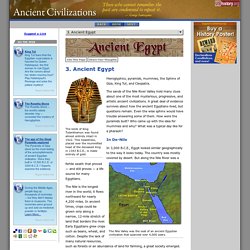
This headdress, placed over the mummified head of the deceased king in 1343 B.C.E., is made entirely of gold. Hieroglyphics, pyramids, mummies, the Sphinx of Giza, King Tut, and Cleopatra. The sands of the Nile River Valley hold many clues about one of the most mysterious, progressive, and artistic ancient civilizations. A great deal of evidence survives about how the ancient Egyptians lived, but questions remain. Even the wise sphinx would have trouble answering some of them. Ancient Egypt - Ancient History. Under Ahmose I, the first king of the 18th dynasty, Egypt was once again reunited.

During the 18th dynasty, Egypt restored its control over Nubia and began military campaigns in Palestine, clashing with other powers in the area such as the Mitannians and the Hittites. The country went on to establish the world’s first great empire, stretching from Nubia to the Euphrates River in Asia. In addition to powerful kings such as Amenhotep I (1546-1526 B.C.), Thutmose I (1525-1512 B.C.) and Amenhotep III (1417-1379 B.C.), the New Kingdom was notable for the role of royal women such as Queen Hatshepsut (1503-1482 B.C.), who began ruling as a regent for her young stepson (he later became Thutmose III, Egypt’s greatest military hero), but rose to wield all the powers of a pharaoh.
Ancient Egyptian religion. Ancient Egyptian religion was a complex system of polytheistic beliefs and rituals which were an integral part of ancient Egyptian society.

It centered on the Egyptians' interaction with many deities who were believed to be present in, and in control of, the forces and elements of nature. The practices of Egyptian religion were efforts to provide for the gods and gain their favor. Formal religious practice centered on the pharaoh, the king of Egypt. Duat. This article is about the Egyptian underworld.
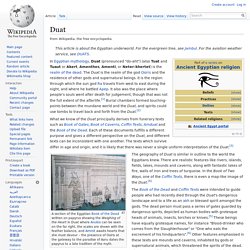
For the evergreen tree, see Jambul. For the aviation weather service, see DUATS. Egyptian pantheon. The gods' complex characteristics were expressed in myths and in intricate relationships between deities: family ties, loose groups and hierarchies, and combinations of separate gods into one.
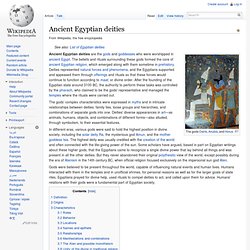
Deities' diverse appearances in art—as animals, humans, objects, and combinations of different forms—also alluded, through symbolism, to their essential features. Imhotep. Statuette of Imhotep in the Louvre Chancellor of the King of Egypt, Doctor, First in line after the King of Upper Egypt, Administrator of the Great Palace, Hereditary nobleman, High Priest of Heliopolis, Builder, Chief Carpenter, Chief Sculptor, and Maker of Vases in Chief.
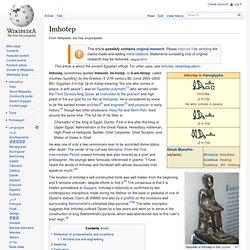
He was one of only a few commoners ever to be accorded divine status after death. The center of his cult was Memphis. From the First Intermediate Period onward Imhotep was also revered as a poet and philosopher. His sayings were famously referenced in poems: "I have heard the words of Imhotep and Hordedef with whose discourses men speak so much. Bastet. Photograph of an alabaster cosmetic jar topped with a lioness, representing Bast, an 18th dynasty burial artifact from the tomb of Tutankhamun circa 1323 BC - Cairo Museum Bastet was a goddess in ancient Egyptian religion, worshipped as early as the Second Dynasty (2890 BC).
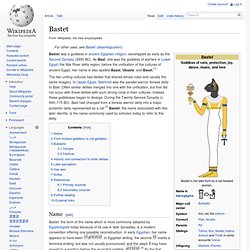
As Bast, she was the goddess of warfare in Lower Egypt, the Nile River delta region, before the unification of the cultures of ancient Egypt. Her name is also spelled Baast, Ubaste, and Baset.[1] The two uniting cultures had deities that shared similar roles and usually the same imagery. Geb. Name[edit] The name was pronounced as such from the Greek period onward and was formerly erroneously read as Seb[1] or as Keb.

The original Egyptian was perhaps "Gebeb"/"Kebeb". It was spelled with either initial -g- (all periods), or with -k-point (gj). The latter initial root consonant occurs once in the Middle Kingdom Coffin Texts, more often in 21st Dynasty mythological papyri as well as in a text from the Ptolemaic tomb of Petosiris at Tuna el-Gebel or was written with initial hard -k-, as e.g. in a 30th Dynasty papyrus text in the Brooklyn Museum dealing with descriptions of and remedies against snakes. Role and development[edit] Goose[edit] Some Egyptologists, (specifically Jan Bergman, Terence Duquesne or Richard H.
This bird-sign is used only as a phonogram in order to spell the name of the god (H.te Velde, in: Lexikon der Aegyptologie II, lemma: Geb). Notes[edit] Jump up ^ cf. Horus. Horus is one of the oldest and most significant deities in ancient Egyptian religion, who was worshipped from at least the late Predynastic period through to Greco-Roman times. Different forms of Horus are recorded in history and these are treated as distinct gods by Egypt specialists.[1] These various forms may possibly be different perceptions of the same multi-layered deity in which certain attributes or syncretic relationships are emphasized, not necessarily in opposition but complementary to one another, consistent with how the Ancient Egyptians viewed the multiple facets of reality.[2] He was most often depicted as a falcon, most likely a lanner or peregrine, or as a man with a falcon head.[3] Etymology[edit] Horus was also known as Nekheny, meaning "falcon".
Some have proposed that Nekheny may have been another falcon-god, worshipped at Nekhen (city of the hawk), with which Horus was identified from early on. Note of changes over time[edit] Ogdoad. Thoth. Thoth played many vital and prominent roles in Egyptian mythology, such as maintaining the universe, and being one of the two deities (the other being Ma'at) who stood on either side of Ra's boat.[5] In the later history of ancient Egypt, Thoth became heavily associated with the arbitration of godly disputes,[6] the arts of magic, the system of writing, the development of science,[7] and the judgment of the dead.[8] Name[edit] Etymology[edit]
Hor-Aha. Hor-Aha (or Aha or Horus Aha) is considered the second pharaoh of the first dynasty of ancient Egypt in current Egyptology. He lived around the thirty-first century BC and is thought to have had a long reign. Identity[edit] Name[edit] Isis. Temple of Isis in Philae, Egypt Isis (Ancient Greek: Ἶσις, original Egyptian pronunciation more likely "Aset" or "Iset") is a goddess in Ancient Egyptian religious beliefs, whose worship spread throughout the Greco-Roman world.
Maat. Nut (goddess) Nut (/nʌt/ or /nuːt/)[1] or Neuth (/nuːθ/ or /njuːθ/; also spelled Nuit or Newet) was the goddess of the sky in the Ennead of Egyptian mythology. Nephthys. Etymology[edit] Seshat. Sekhmet. Set (mythology) Ancient History Encyclopedia. NatGeo: King Tut Revealed. By A.R. Williams He was just a teenager when he died. The last heir of a powerful family that had ruled Egypt and its empire for centuries, he was laid to rest laden with gold and eventually forgotten. Since the discovery of his tomb in 1922, the modern world has speculated about what happened to him, with murder the most extreme possibility. Now, leaving his tomb for the first time in almost 80 years, Tut has undergone a CT scan that offers new clues about his life and death—and provides precise data for an accurate forensic reconstruction of the boyish pharaoh.
Inside King Tut’s subterranean burial chamber, against a backdrop of sacred murals, Zahi Hawass, head of Egypt’s Supreme Council of Antiquities, removes padding to reveal the young pharaoh’s remains. Clues From Top ... BBC History: The Story of the Nile.